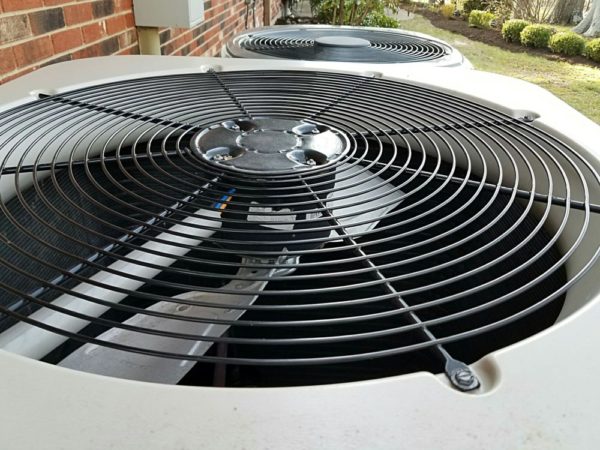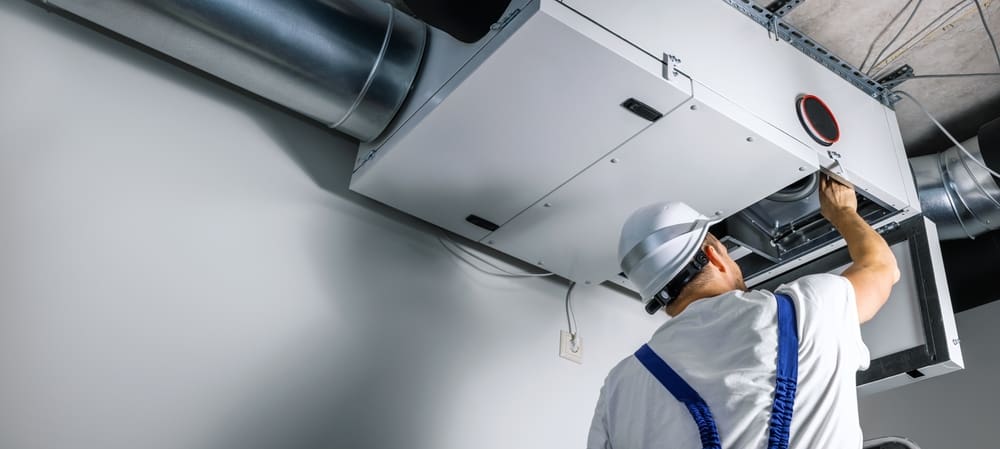
An HRV is a heat recovery ventilator, while an ERV is an energy recovery ventilator. Let’s take a look at how they work and what advantages they can offer you.
The Heat Recovery Ventilator (HRV)
The HRV is a passive ventilation system that transfers heat between the supply and exhaust air streams. It is more common in colder climates and helps to reduce the amount of energy needed to heat your home. The HRV does this by recovering 60% to 80% of heating energy, meaning it removes stale air from inside your home and replaces it with fresh air from outside. It does this while extracting valuable warmth from the thick air as it leaves your home.
The Energy Recovery Ventilator (ERV)
An ERV works to cool and dehumidify the air. This is ideal for hot and humid climates, as it will help control the temperature and moisture in your home. Most homes have an open ventilation system like an attic fan or a window-mounted unit. However, since these systems are continuously drawing fresh air into your home while exhausting stale indoor air from it, they require a lot of energy to run efficiently.
As this process occurs all day, you can see how it drastically affects your monthly energy bill. Luckily for homeowners with AC units, an ERV will help reduce the amount of work needed by cooling and dehumidifying outdoor air before bringing it inside. This will allow your AC unit to operate less frequently, which means more money in your pocket.
How Do HRVs and ERVs Work?
HRV/ERV systems work by pulling air into the building through an intake duct or grille, where it travels through a heat exchanger before being distributed throughout the building. During this process, stale air is pulled out of the building simultaneously. A fan creates suction to pull in new air and exhaust contaminated air. The heat exchanger transfers energy from one side of itself to the other without allowing airflow between them.
In HRV systems, which do not contain filters, two water-moistened streams of air move in opposite directions through a heat exchanger core and transfer their energy to each other without actually mixing; then, they are separately directed into and out of the home. An ERV system includes specially engineered filters that remove particles such as pollen, dust, odors, and smoke from fresh outdoor air before being brought inside your home.
What Are the Differences Between the Two?
Knowing the difference between an HRV and an ERV is essential when choosing a ventilation system for your home. An HRV transfers heat but not necessarily humidity or air. An effective HRV should move both warm and cool air from side to side to ensure that fresh, cool air is entering your home in the summer and fresh, warm air is entering your home during colder months. Because an HRV does not transfer humidity or air, it makes sense that it would be less expensive than an ERV. However, there are some drawbacks to using an HVR because it does not transfer humidity.
Humidity can cause condensation in the ductwork, which leads to mold growth within the ductwork itself. Additionally, although it may seem like a good idea to save money with an HVR if you live in a climate with high humidity (over 50%), you may want to consider purchasing an ERV because of its ability to deal with moisture buildup.
Benefits of a Heat Recovery Ventilator
Heat recovery ventilators are designed to:
- Provide continuous fresh air at consistent temperatures throughout your home. This will help you maintain comfortable conditions and improve indoor air quality.
- Reduce energy costs by transferring heat between outgoing and incoming air streams rather than exhausting conditioned air and having to produce more heated or cooled air for your home’s interior spaces
- Reduce noise levels with fans that run quietly, unlike a standard fan that you would need to exhaust stale indoor air from your house without an HRV
Benefits of an Energy Recovery Ventilator
One of the most significant benefits of an ERV is its ability to balance the humidity levels in your home. This can help keep things comfortable, regardless of what is going on outside. Plus, you can turn off your air conditioner and save money.
The ERV will also neutralize any unwanted smells and airborne gases (such as carbon dioxide or formaldehyde), removing them from your home. Some systems even utilize activated carbon filters or UV light bulbs designed to eliminate volatile organic compounds (VOCs) and other particulates before they enter your living space.

Factors to Consider When Buying an HRV/ERV
It’s important to do some research before you decide which type of ventilator to purchase. Keep the following factors in mind:
1. Installation
If you want to install your air exchanger in a tight space, or if your home doesn’t have an attic or basement where you can put it, you’ll have to make sure the unit can be easily installed.
- How many parts are there? The fewer, the better.
- Are there any mandatory installation restrictions? Does it need a minimum distance from walls, ceilings, and so on?
- How much does it weigh? If it’s heavy, will you be able to lift it into place by yourself? Will you need someone else to help with the installation?
- How difficult is it to install? For example, some models don’t require extensive rerouting of ductwork.
2. Ice Prevention
The heat exchanger must be designed to prevent overheating and injury to the occupants should some type fail. A sensor and control circuit should be included in all HRV/ERVs to monitor any overheating situation. Shut off the motor, or reduce its speed before damage can occur. The heat exchanger should also be protected from snow, ice, and freezing temperatures so that it can operate properly.
The best way to accomplish this is by installing a model that incorporates an internal bypass system that will cause the air to move through the heat exchanger only when necessary, thus avoiding most problems associated with overheating. Also, do not install the unit where it will always have a buildup of snow or ice. Instead, put it in a protected area where airflow around it will prevent freezing.
3. Energy Recovery
While ERVs use more power than HRVs, they can transfer humidity and heat. This is especially useful in humid climates because if you do not move the moisture from your house in addition to the stale air, you will just be bringing in more stale air with higher relative humidity. Moisture can cause mold growth and wood rot, so it’s better not to take any chances here. ERVs are also great for colder regions because they can bring moisture from the fresh air back into your home to keep the atmosphere from drying out too much.
Fresh air is a significant component of human well-being, and it can be hard to bring indoors during extreme temperatures when windows remain closed. Thankfully, the HRV/ERV systems take care of this problem and allow you to simultaneously heat or cool your home and bring in fresh air from outside.
Upgrade Your Home’s Ventilation with Expert HVAC Services
Whether you need ventilation solutions, AC repairs, heating services, or plumbing assistance, BEST Air Conditioning Plumbing Repair has you covered. Our skilled technicians provide expert installation, maintenance, and repairs to keep your home running smoothly. Call us today at (702) 970-4911 or schedule an appointment online for top-rated HVAC and plumbing services in Las Vegas!

